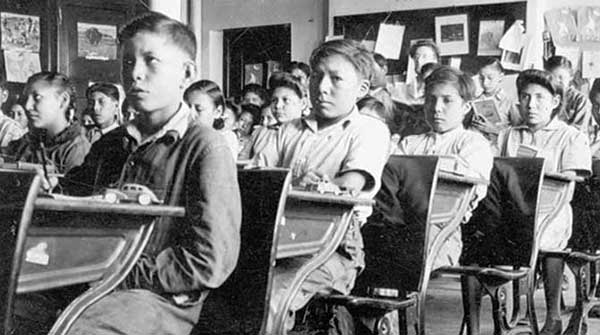The facts don’t support the TRC’s claim of cultural genocide in Indigenous residential schools
 On June 2, 2015, the day the Summary Final Report of the Truth and Reconciliation Commission (TRC) was released, Prime Minister Justin Trudeau vowed that a Liberal government would take “immediate action” to implement all its 94 recommendations.
On June 2, 2015, the day the Summary Final Report of the Truth and Reconciliation Commission (TRC) was released, Prime Minister Justin Trudeau vowed that a Liberal government would take “immediate action” to implement all its 94 recommendations.
By this, Trudeau meant that he accepted the Report’s central assertion the Indian Residential Schools (IRSs) enacted “cultural genocide.” He is not alone in this belief. Even former Conservative Prime Minister Stephen Harper acknowledged the IRSs tried to “kill the Indian in the child.”
If true, surely that was cultural genocide.
The first government-mandated IRS opened 342 years after Jacques Cartier landed in what is now Canada. Even the TRC Report obliquely acknowledges that this long period of cultural contact saw much aboriginal cultural transformation. The historical record also reveals that Aboriginals abandoned many of their traditional beliefs and practices for Western technology, medicine, foodstuffs, religion, and languages from first contact to the present.
 Anglican Church Archives, Old Sun |
| Related Stories |
| Catholic Church finally repudiates the Doctrine of Discovery
|
| Did children die attending residential schools?
|
| Why did residential schools stay open long after Ottawa wanted to close them?
|
In short, children entered IRSs with their pre-contact cultural systems already lost or substantially transformed.
To challenge the validity of the cultural genocide label is not to deny the harsh physical and heinous sexual abuse that sometimes occurred at these often poorly run, maintained, and underfunded schools, much of it committed by the students themselves. These facts are undeniably true, but they do not add up to forced cultural destruction, partly because the term itself has no legal definition.
Indeed, the concept is so elastic that it could easily be stretched to include the schoolchildren of non-European immigrants to Canada, long required by law to be “Canadianized” in state-mandated public schools whether they or their parents favour this assimilation or not.
This may explain why cultural genocide was excluded from the five grounds listed in the 1948 United Nations Convention on the Prevention and Punishment of the Crime of Genocide. The Convention addresses only the deliberate destruction of a “national, ethnical, racial, or religious group” through various physical means. Thus, it was inaccurate for the TRC to claim that the largely voluntary attendance at residential schools falls under the Convention’s provisions.
The Convention does recognize in Article 2(e) that genocide can involve “forcibly transferring children from one group to another group.” This might apply, for example, when Boko Haram jihadists in Nigeria kidnap hundreds of Christian schoolgirls, force them to accept Islam and marry them off to their fighters. But this is not in the same league as Canadian aboriginal children temporarily attending boarding schools to obtain a Western education.
Large-scale attendance at IRSs was in effect only between 1920 and 1948. Moreover, no more than one-third of aboriginal children born during the history of residential schools, 1883-1996, attended them, their average stay being just 4.5 years. And nearly all students returned home for summer and Christmas vacations. The TRC Report itself says that truancy rates were “epidemic” at some schools.
None of these facts support cultural genocide.
The cultural genocide charge is further undermined by the fact that the provision of a Western education was often requested by Aboriginals and entrenched in six of the seven numbered treaties negotiated in Western Canada. Treaty Six, for example, promised that “Her Majesty [Queen Victoria] agrees to maintain schools for instruction in such reserves hereby made as to Her Government of the Dominion of Canada may seem advisable, whenever the Indians of the reserve shall desire it.”
In short, residential schools were established on the well-founded and altruistic notion that what remained of aboriginal beliefs and lifestyles in 1883, together with the various social and economic adversities that were supplanting them – what the TRC Report called “the significant educational, income, health, and social disparities between Aboriginal people and other Canadians” – were incompatible with just and equitable participation of all people in a rapidly developing and modernizing country. The federal government, along with several Christian denominations, saw their duty as helping indigenous people adapt to these realities.
In developed countries like Canada, much of this inter-group disparity in life-chance outcomes is best explained as the product of widespread multi-generational poverty, drug addiction, and welfare dependency: the TRC Report itself claims that during the 1950s and 1960s, up to 50 percent of IRS students were orphans or the offspring of “broken homes.”
In other words, residential schools look like an effort by the federal government and the churches to save both the Indian and the child.
Hymie Rubenstein, a retired professor of anthropology at the University of Manitoba, is editor of REAL Indigenous Report and REAL Israel & Palestine Report. Professor Rubenstein and Rodney Clifton are the authors of Residential School Recrimination, Repentance, and Reality for the Frontier Centre for Public Policy.
For interview requests, click here.
The opinions expressed by our columnists and contributors are theirs alone and do not inherently or expressly reflect the views of our publication.
© Troy Media
Troy Media is an editorial content provider to media outlets and its own hosted community news outlets across Canada.

